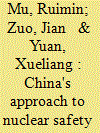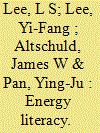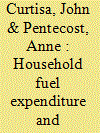|
|
|
Sort Order |
|
|
|
Items / Page
|
|
|
|
|
|
|
| Srl | Item |
| 1 |
ID:
137667


|
|
|
|
|
| Summary/Abstract |
In this paper, we discuss the prospects of agricultural biogas plants. We conducted an integrated SWOT–AHP analysis for such plants in Austria in order to identify strengths, weaknesses, opportunities and threats (SWOT factors), and to weight the factors identified based on expert judgments, calculated according to the Analytic Hierarchy Process (AHP) method. The results show that financial aspects are dominant in three of the four SWOT categories. Technological aspects and issues regarding utilization seem to play a relatively minor role. Factors that are not directly under the control of plant operators are currently perceived as crucial for the success of agricultural biogas plants. We conclude that such plants will only succeed in contributing to sustainable energy supply goals when economic and political conditions are favorable over the long term.
|
|
|
|
|
|
|
|
|
|
|
|
|
|
|
|
| 2 |
ID:
137658


|
|
|
|
|
| Summary/Abstract |
As countries move toward larger shares of renewable electricity, the slow diffusion of active electricity load management should concern energy policy makers and users alike. Active load management can increase capacity factors and thereby reduce the need for new capacity, improve reliability, and lower electricity prices. This paper conceptually and empirically explores barriers to load shift in industry from an end-user perspective. An online survey, based on a taxonomy of barriers developed in the realm of energy efficiency, was carried out among manufacturing sites in mostly Southern Germany. Findings suggest that the most important barriers are risk of disruption of operations, impact on product quality, and uncertainty about cost savings. Of little concern are access to capital, lack of employee skills, and data security. Statistical tests suggest that companies for which electricity has higher strategic value rate financial and regulatory risk higher than smaller ones. Companies with a continuous production process report lower barrier scores than companies using batch or just-in-time production. A principal component analysis clusters the barriers and multivariate analysis with the factor scores confirms the prominence of technical risk as a barrier to load shift. The results provide guidance for policy making and future empirical studies.
|
|
|
|
|
|
|
|
|
|
|
|
|
|
|
|
| 3 |
ID:
137673


|
|
|
|
|
| Summary/Abstract |
In 2013, China׳s national government abandoned its previous cautious policy and started to promote large-scale deployment of coal-based synthetic natural gas (SNG). Coal-based SNG is both carbon-intensive and very water-intensive. Driven by a smog crisis and the recession of coal industry, China׳s 2013 policy change is major setback in its long-term efforts in carbon mitigation and water conservation. The government of China made the policy change before the commercial commencement of China׳s first SNG demonstration plant. Since the commencement of China׳s SNG demonstration plant, many problems have started to appear. In this article, I discuss the nature of demonstration project and explain the danger in starting a crash program without evaluating the demonstration comprehensively and transparently.
|
|
|
|
|
|
|
|
|
|
|
|
|
|
|
|
| 4 |
ID:
137674


|
|
|
|
|
| Summary/Abstract |
Nuclear energy plays an important role in the energy sector in the world. It has achieved a rapid development during the past six decades and contributes to over 11% of the world's electricity supply. On the other side, nuclear accidents have triggered substantial debates with a growing public concern on nuclear facilities. Followed by the Fukushima nuclear accident, some developed countries decided to shut down the existing nuclear power plants or to abandon plans to build new ones. Given this background, accelerating the development of nuclear power on the basis of safety in China will make it a bellwether for other countries. China assigns the top priority to the nuclear safety in nuclear energy development and has maintained a good record in this field. The policy and institutional system provide the necessary guarantee for the nuclear energy development and safety management. Furthermore, China's approach to nuclear safety provides a benchmark for the safe development and utilization of nuclear power. This research draws an overall picture of the nuclear energy development and nuclear safety in China from the policy and institutional perspective.
|
|
|
|
|
|
|
|
|
|
|
|
|
|
|
|
| 5 |
ID:
137656


|
|
|
|
|
| Summary/Abstract |
Integrated assessment models (IAMs) are increasingly used to evaluate carbon policy impacts on energy structure, but different models can yield considerably different results. This paper seeks to frame model results for policymakers and other consumers of model outputs. In this analysis we compare three models: GCAM, MERGE, and EPPA. We apply diagnostic carbon price scenarios, such as ramps and shocks, to identify key differences in model behavior that drive inter-model variability in projected policy impacts on the U.S. energy system. We report model results using several economic parameterizations and find that variation in carbon emissions across models results primarily from differences in carbon intensity of energy supply. These differences arise because models include different low-carbon energy technology options and vary widely in how flexible the electricity supply sector is at adapting to a change in policy. The timing of emissions abatement is also strongly influenced by whether the model is a simulation or an inter-temporal optimization scheme and the amount of foresight exhibited in the model. Our analysis demonstrates the usefulness of novel IAM diagnostic indicators and clarifies model features that are highly relevant for consumers of model results.
|
|
|
|
|
|
|
|
|
|
|
|
|
|
|
|
| 6 |
ID:
137665


|
|
|
|
|
| Summary/Abstract |
Hong Kong's electricity service is superbly reliable and price-reasonable when compared to those of the major cities in the OECD countries. Based on the rate of return regulation in the U.S., the current scheme of control agreement (SCA) regulating the two local integrated investor-owned utilities (IOUs) will expire in 2018 (or in 2023 after an optional 5-year extension), thus offering an opportune time to consider proposals with long lead time to modify or replace the SCA. The proposals made to date range from modifications of the SCA to electricity market restructure. These proposals, however, overlook two important aspects of regulatory governance: transparency and public involvement. This paper estimates consumer support for the proposal to establish a Hong Kong public utilities commission (HKPUC) to improve the current regulatory process. Based on the responses collected in mid-2014 via a face-to-face survey of 1100 Hong Kong residents, we find that at the 1.5% bill surcharge, about 70% the respondents are estimated to support an HKPUC. Thus, there is sufficient consumer support for a financially viable HKPUC, implying that Hong Kong should consider the possibility of establishing an HKPUC, notwithstanding the substantial challenges to be overcome prior to its implementation.
|
|
|
|
|
|
|
|
|
|
|
|
|
|
|
|
| 7 |
ID:
137663


|
|
|
|
|
| Summary/Abstract |
Electricity generated by renewable energies (RES-E) already accounts for 25% of Germany’s electricity supply. This has led to recent discussions for a better market integration of RES-E. The paper examines how competing actors and their ideas on market integration developed new services for direct marketing according to their respective origins and tried to shape the regulatory framework. The paper analyses this process and explains the current shape of the field of direct marketing. Medium-sized structured actors, who favoured RES-E integration via the conventional wholesale power markets, and who formed early close coalitions with RES-E power producers at the same time, have been most successful in terms of market shares. Moreover, they have been very successful for different reasons in building-up coalitions with governance units and influencing the field rules and routines. Based on those findings, the paper will conclude with some policy advices for the future adjustment of the current regulative frameworks. As long as there is no evidence of how RES-E can be integrated most effectively and efficiently, policies should maintain a competition between different direct marketing strategies to find out which strategies serve the best in terms of achieving a successful energy transition.
|
|
|
|
|
|
|
|
|
|
|
|
|
|
|
|
| 8 |
ID:
137653


|
|
|
|
|
| Summary/Abstract |
The Nigerian government proposed the use of compressed natural gas (CNG) as an automotive fuel in 1997 as part of the initiatives to harness natural gas (NG) resources but progress has been slow. This paper examines the natural gas vehicle (NGV) implementation approaches and outcomes in seven countries with diverse experiences in order to gain an understanding of the barriers to the NGV market development in Nigeria. The analysis employs hermeneutic principles to secondary data derived from academic literature, published reports from a variety of international agencies, grey literature, and text from online sources and identifies eight success factors for NGV market development namely: strategic intent, legal backing, learning and adaptation, assignment of responsibilities, financial incentives, NG pricing, consumer confidence, and NG infrastructure. The paper concludes that the principal impediment to NGV market development in Nigeria is the uncoordinated implementation approach and that greater government involvement is required in setting strategic goals, developing the legal and regulatory frameworks, setting of clear standards for vehicles and refuelling stations as well as assigning responsibilities to specific agencies. Short-term low cost policy interventions identified include widening the existing NG and gasoline price gap and offering limited support for refuelling and retrofitting facilities.
|
|
|
|
|
|
|
|
|
|
|
|
|
|
|
|
| 9 |
ID:
137668


|
|
|
|
|
| Summary/Abstract |
The belief that small hydropower (SHP) systems are sources of clean energy with few or no ecological problems has been driving the rapid expansion of SHP plants in China and elsewhere. This paper presents an evaluation of the ecological impacts of SHP based on an emergy analysis of a plant located in Guizhou Province in southwest China. The results suggest that periodic downstream drying-up of the river is the largest contributor to the induced ecological impacts in terms of emergy cost. In 2010, the ecosystem service losses caused by downstream ecosystem degradation totaled 2.35E+18 seJ, which accounts for 38% of the total emergy utilized in the annual operation of this plant. If such losses could be avoided, i.e., if the SHP operated as designed, SHP projects would produce relatively modest impacts on the environment. When the reaches downstream of the SHP plant are not affected, the environmental loading ratio (ELR) is 2.20 and the emergy sustainability index (ESI) is 0.93; however, the ELR increases to 3.82 and ESI decreases to 0.38 when river drying-up occurs. These results indicate that China should rigorously investigate potential ecological problems of SHP development and proceed with caution rather than readily believing unjustified assumptions.
|
|
|
|
|
|
|
|
|
|
|
|
|
|
|
|
| 10 |
ID:
137666


|
|
|
|
|
| Summary/Abstract |
Energy literacy that can empower people to make thoughtful decisions and take responsible actions is more important as energy shortages have become pressing issues in the world. Energy literacy was measured among a sample of 2400 secondary students involved in a national energy education program in Taiwan. Response patterns related to student background and factors determining energy consumption behaviors were also studied. Energy literacy was high and positive, with greater impact as expected by grade (senior high school students outscored junior high school ones) and there were some effects due to gender and socioeconomic status. Students' performance on energy knowledge was acceptable (over 60% correct across grades) while a notable discrepancy between affect and behavior was identified indicating that there might not be a correspondence between what people say they would do and what they actually do. Energy saving behavior was more closely associated with the affect than other variables. Reasons for the findings and implications for energy education in the future are discussed.
|
|
|
|
|
|
|
|
|
|
|
|
|
|
|
|
| 11 |
ID:
137664


|
|
|
|
|
| Summary/Abstract |
South Korea is experiencing a serious imbalance in electricity supply and demand, which caused a blackout in 2011. The Korean government has planned to perform a rolling blackout to prevent large-scale blackouts when the electricity supply reserve margin reaches less than 1 million kW. This study attempts to estimate the inconvenience cost of household customers from a rolling blackout by using survey data. To this end, we apply a contingent valuation method (CVM) to measure their willingness-to-pay (WTP) in order to avoid a rolling blackout, i.e. the suspension of electricity supply. In this study, we estimate the inconvenience costs stemming from both an unannounced and an announced rolling blackout. As a result, we find that the inconvenience cost of a sudden rolling blackout is estimated at 3900.67 KRW (3.56 USD) per month per household, while that of an announced rolling blackout stands at 3102.95 KRW (2.83 USD). This difference in costs shows that people place value in receiving prior notice of a blackout, and that inconvenience costs of between 166.0 billion KRW (151.6 million USD) and 174.3 billion KRW (159.2 million USD) per year can be reduced nationwide by giving households advance notice of a planned rolling blackout.
|
|
|
|
|
|
|
|
|
|
|
|
|
|
|
|
| 12 |
ID:
137670


|
|
|
|
|
| Summary/Abstract |
China implemented a package of policies during the 11th Five-Year Plan (2006–2010) to improve industrial energy efficiency. This assessment provides a methodology that establishes a causal relationship between policy implementation and energy conservation effects. To enhance the confidence in the research findings, this assessment applies two distinctive and independent approaches: one top-down and the other bottom-up. This assessment finds that industrial energy efficiency policies collectively achieved energy savings of 322 Mtce (9.4 EJ) against the baseline scenario. This accounted for 59% of the sector's total energy savings from 2006 to 2010. The remaining energy savings were realised through autonomous technology improvement (33%) and sector-level structural shift (8%). Correspondingly, cumulative avoided CO2 emissions realised through energy efficiency policies amounted to 760 million tons. This assessment concludes that industrial energy efficiency policies were effective in realising energy conservation targets, but energy conservation effects were not achieved in a cost-effective way. Command and control measures were dominantly implemented, with economic incentives and informational measures taking a complementary role; while market based instruments did not play an important role. As China is planning on implementing a nationwide emissions trading scheme, special attention needs to be paid to policy interaction and coordination.
|
|
|
|
|
|
|
|
|
|
|
|
|
|
|
|
| 13 |
ID:
137661


|
|
|
|
|
| Summary/Abstract |
This paper examines the relationship between residential buildings׳ energy efficiency labels and household energy expenditure, complementing an existing literature comparing theoretical and actual energy use. Residential building energy performance certificates indicate a theoretical energy use based on standardised assumptions about occupancy and energy service demand and are a market signal about the energy performance of a property. This paper quantifies the empirical relationship between households’ expenditure on fuel and building energy performance using household expenditure survey data from the Republic of Ireland. The extent of this relationship, i.e. the size of the elasticity parameter, is of direct relevance to policy makers in the context of energy efficiency and climate policy targets. With building energy efficiency measured as a 15-point scale, we find that each rating decline along the scale is associated with a reduction in energy expenditure of 1.6%.
|
|
|
|
|
|
|
|
|
|
|
|
|
|
|
|
| 14 |
ID:
137671


|
|
|
|
|
| Summary/Abstract |
This paper aims to synthetically investigate invention profiles and uneven growth of technological knowledge in the emerging nano-energy field, based on patents data extracted from the Derwent Innovation Index (DII) database during the time period 1991–2012. The trend analysis shows that invention in this field has experienced enormous growth and also diversification over the past 22 years. The co-occurrence network of burst technology domains reveals that technology domains constantly burst, and innovative progress in nanotechnology has tremendously contributed to energy production, storage, conversion and harvesting and so on. Nano-energy patented inventions mainly come from a combinatorial process with a very limited role of developing brand-new technological capabilities. Reusing existing technological capabilities including recombination reuse, recombination creation and single reuse is the primary source of inventions. For the impacts of technology networks' embeddedness, we find that network tie strength suppresses the growth of technological knowledge domains, and network status and convergence both facilitate the growth of technological knowledge domains. We expect that this study will provide some enlightenment for inventing or creating new knowledge in emerging fields in complex technological environment.
|
|
|
|
|
|
|
|
|
|
|
|
|
|
|
|
| 15 |
ID:
137669


|
|
|
|
|
| Summary/Abstract |
This study investigates the existence of the environmental Kuznets curve (EKC) hypothesis in Vietnam during the period 1981–2011. To realize the goals of this study, a pollution model was established applying the Autoregressive Distributed Lag (ARDL) methodology. The results revealed that the pollution haven hypothesis does exist in Vietnam because capital increases pollution. In addition, imports also increase pollution which indicates that most of Vietnam's imported products are energy intensive and highly polluted. However, exports have no effect on pollution which indicates that the level of exports is not significant enough to affect pollution. Moreover, fossil fuel energy consumption increases pollution while renewable energy consumption has no significant effect in reducing pollution. Furthermore, labor force reduces pollution since most of Vietnam's labor force is in the agricultural and services sectors which are less energy intensive than the industrial sector. Based on the obtained results, the EKC hypothesis does not exist because the relationship between GDP and pollution is positive in both the short and long run.
|
|
|
|
|
|
|
|
|
|
|
|
|
|
|
|
| 16 |
ID:
137652


|
|
|
|
|
| Summary/Abstract |
Cumulative energy demand (CED) estimates from life cycle assessments (LCAs) are increasingly used to determine energy return on investment (EROI), but the difference in indicators can lead to a misclassification of energy flows in the assessment. The core idea of EROI is to measure the relation of energy diverted from society to make energy available to society. CED, on the other hand, includes forms of energy that are not appropriated by society, such as fugitive methane emissions from oil wells as well as losses of heating value of coal during transport and storage. Such energy forms should be excluded from EROI; failure to do so leads to results that are inconsistent with the intention of EROI and potentially misleading. We demonstrate how this problem is at least partially rectifiable by adopting consistent energy accounting, but also note that among the energy flows not appropriated by society occurring in CED, not all flows can easily be removed. Further, we point to inconsistencies in heating value assumptions in a widely used database that have misled analysts. Finally, we argue that the differential weighting of primary energy forms in published CED-based EROI work is unsubstantiated and should be reconsidered.
|
|
|
|
|
|
|
|
|
|
|
|
|
|
|
|
| 17 |
ID:
137659


|
|
|
|
|
| Summary/Abstract |
A generation portfolio modelling was employed to assess the expected costs, cost risk and emissions of different generation portfolios in the Australian National Electricity Market (NEM) under highly uncertain gas prices, carbon pricing policy and electricity demand. Outcomes were modelled for 396 possible generation portfolios, each with 10,000 simulations of possible fuel and carbon prices and electricity demands. In 2030, the lowest expected cost generation portfolio includes 60% renewable energy. Increasing the renewable proportion to 75% slightly increased expected cost (by $0.2/MWh), but significantly decreased the standard deviation of cost (representing the cost risk). Increasing the renewable proportion from the present 15% to 75% by 2030 is found to decrease expected wholesale electricity costs by $17/MWh. Fossil-fuel intensive portfolios have substantial cost risk associated with high uncertainty in future gas and carbon prices. Renewables can effectively mitigate cost risk associated with gas and carbon price uncertainty. This is found to be robust to a wide range of carbon pricing assumptions. This modelling suggests that policy mechanisms to promote an increase in renewable generation towards a level of 75% by 2030 would minimise costs to consumers, and mitigate the risk of extreme electricity prices due to uncertain gas and carbon prices.
|
|
|
|
|
|
|
|
|
|
|
|
|
|
|
|
|
|
|
|
|